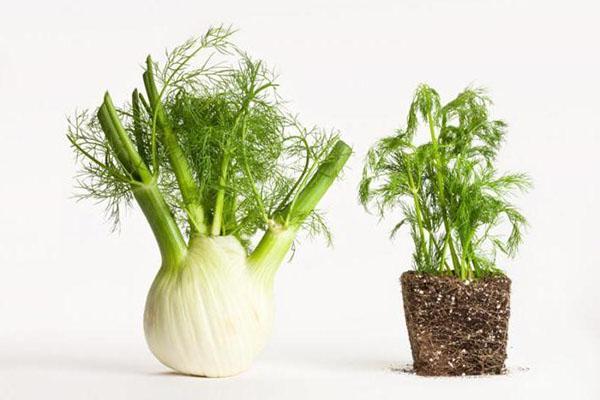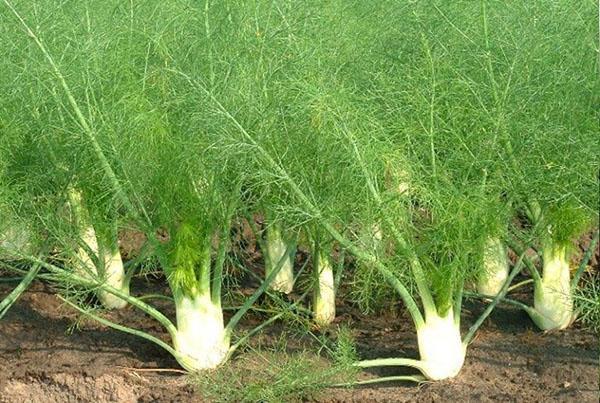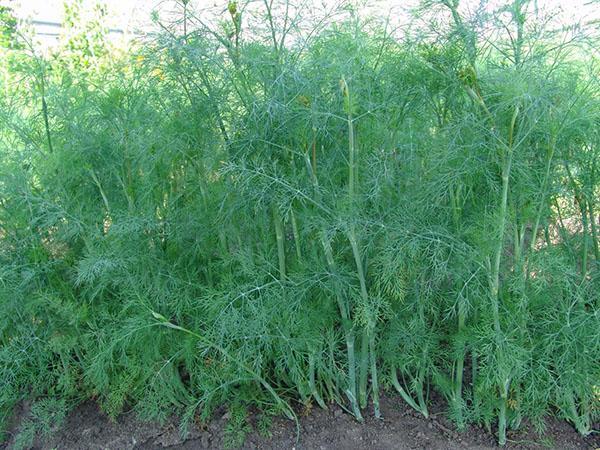The difference between fennel and dill: the main benefits of plants
 Many do not know what is the difference between fennel and dill. Externally, the plants are very similar, so they are often confused with each other. In fact, these are completely two different seasonings that have their own taste and have their own set of vitamins and minerals. Both fennel and dill are used in the food industry and in folk medicine. Due to their unique properties, they are able to cure various diseases.
Many do not know what is the difference between fennel and dill. Externally, the plants are very similar, so they are often confused with each other. In fact, these are completely two different seasonings that have their own taste and have their own set of vitamins and minerals. Both fennel and dill are used in the food industry and in folk medicine. Due to their unique properties, they are able to cure various diseases.
Fennel: plant description

Deciduous plates in fennel are ovoid. The upper ones are widened, the lower ones are dense and are on long petioles. Flowers are presented in the form of an umbrella inflorescence. Its diameter reaches 20 cm. The petals are yellowish. Their width does not exceed 1 mm. At the end of flowering, fruits appear in the form of grains. They have an elongated oval shape. Grains grow up to 1 cm in length and about 3 mm in width.
Popularly, fennel is often called pharmaceutical dill or voloshsky dill, but it is worth remembering that this is one and the same plant.
Fennel composition:
- many different essential oils;
- vitamins (B, A);
- amino acids;
- phytosterol;
- biotin;
- different macro- and microelements.
In the culinary industry, all parts of the plant are used. Both the green mass and the root part have a high taste. When fresh, it very much resembles anise... The leaves have a tangy taste and a rich spicy aroma.
Fennel fruit is used as a seasoning for hot dishes. The green mass is added to salads. Umbrella inflorescences are suitable for preserving vegetables.
Fennel has properties:
- antispasmodic;
- expectorant;
- antimicrobial.
Fennel is grown using seeds. The grains are sown in early April, when the night frosts will pass. This is an important condition as the twigs are very sensitive to low temperatures. Flowering can be seen in June, and the first fruits appear in August.
Almost everyone can use such a plant. It is not recommended to add fennel to food for those who have individual intolerance.
Large amounts of fresh spice can cause nausea, dizziness, vomiting, and indigestion.
Description of the appearance of dill
 Dill is an annual plant that belongs to the umbrella family. In nature, it can be seen practically on all continents. The stem of dill grows up to 150 cm. It is often straight, but there are varieties that have a slight branching. The leaves are also ovoid and pinnately dissected. At the ends, they become threadlike. The buds are small. When loose, they have a yellow tint. Inflorescences are pillow-shaped. Each umbrella consists of 20-50 rays of almost the same size. The fruits are fragrant, small. Their length ranges from 5 mm, and their width is 3 mm.
Dill is an annual plant that belongs to the umbrella family. In nature, it can be seen practically on all continents. The stem of dill grows up to 150 cm. It is often straight, but there are varieties that have a slight branching. The leaves are also ovoid and pinnately dissected. At the ends, they become threadlike. The buds are small. When loose, they have a yellow tint. Inflorescences are pillow-shaped. Each umbrella consists of 20-50 rays of almost the same size. The fruits are fragrant, small. Their length ranges from 5 mm, and their width is 3 mm.
It is strongly not recommended to use dill for people with low blood pressure.
Dill is rich in:
- folic acid;
- flavonoids;
- essential oils;
- iron;
- phosphorus;
- potassium;
- vitamins (C, P, B).
 The green mass contains nicotinic and ascorbic acid, the percentage of which is very high. The leaves also contain dietary fiber, ash, amino acids.In addition to the above substances, dill grains contain about 18% fatty oil. It has strong therapeutic properties. Also, the seeds are very high in vegetable protein.
The green mass contains nicotinic and ascorbic acid, the percentage of which is very high. The leaves also contain dietary fiber, ash, amino acids.In addition to the above substances, dill grains contain about 18% fatty oil. It has strong therapeutic properties. Also, the seeds are very high in vegetable protein.
Dill oil is used not only in cosmetology, but also for the treatment of cardiovascular diseases.
Compared to fennel, dill has a very strong odor. Which caused its incredible popularity among culinary specialists. It is used almost everywhere. Dry or fresh dill is added to soups, salads, cereals, preservation.
Dill is propagated by seeds, which are sown immediately after the snow has melted. The planting material of this plant is highly germinating. Grains germinate even at +60 C. Seedlings appear within 5 days after planting. You can thin out young plants after they grow about 7 cm in height.
The plant is distinguished by its unpretentiousness. In order for the dill to be beautiful and healthy, you do not need to fertilize and choose a place for planting. It can be sown even between rows strawberry and other plants.
The difference between fennel and dill
 Distinguishing these two plants is actually not difficult. You can see the difference by carefully examining the stems of the seasonings.
Distinguishing these two plants is actually not difficult. You can see the difference by carefully examining the stems of the seasonings.
The main differences between fennel and dill:
- care and rules for growing in the garden;
- aroma and taste;
- the composition of vitamins and minerals;
- use in cooking;
- the appearance of plants.
These two plants differ in the shape of the root system. Dill has a small and very hard root. In an adult plant, it is deeply buried in the soil and has a straight shape. Fennel is distinguished by a fleshy horse with an impressive diameter.
 You can also distinguish fennel by looking at the seeds. The grains of this plant are slightly longer. They have a peculiar smell and composition of nutrients, thanks to which they are often used to treat many diseases. Often grains are brewed and given to babies to combat colic. This Dill water also relieves pain in the abdomen and reduces gas production.
You can also distinguish fennel by looking at the seeds. The grains of this plant are slightly longer. They have a peculiar smell and composition of nutrients, thanks to which they are often used to treat many diseases. Often grains are brewed and given to babies to combat colic. This Dill water also relieves pain in the abdomen and reduces gas production.
Decoctions are prepared from the plant grains, which have a strong diuretic effect. They are used to normalize the menstrual cycle and increase appetite. Also, seeds lower blood pressure and are able to normalize all the digestive processes of the body.
Every housewife should know how fennel differs from dill. Only in this way will it be possible to give the dishes an incredible taste and make them more tasty and healthy.